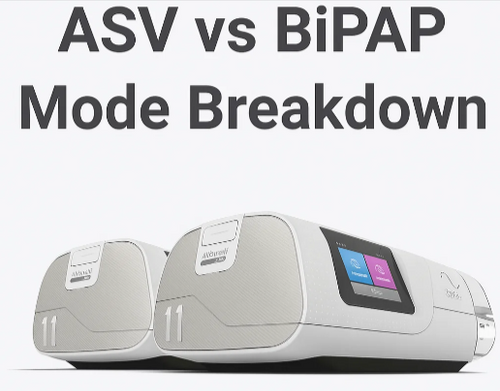ASV vs. BiPAP: Navigating Advanced Sleep Apnea Therapies
Sleep apnea disrupts restful sleep and has far-reaching consequences on cardiovascular health, cognition, and quality of life. While CPAP (Continuous Positive Airway Pressure) remains a standard therapy for obstructive sleep apnea (OSA), more severe or complicated cases often require BiPAP or ASV. Understanding the differences can empower patients to have informed discussions with their sleep specialists.
What Is BiPAP?
BiPAP (Bilevel Positive Airway Pressure) delivers two fixed pressure levels: a higher pressure during inhalation (IPAP) and a lower one during exhalation (EPAP). Typical use cases include:
-
Obstructive sleep apnea (OSA): Particularly helpful if patients struggle with CPAP, especially at higher pressures, since BiPAP eases the effort needed to exhale
-
Comorbid respiratory conditions: Beneficial for individuals with COPD, congestive heart failure, or neuromuscular respiratory weakness .
-
Central sleep apnea (CSA): BiPAP ST (Spontaneous/Timed) includes a backup rate to ensure a minimal respiratory rate during central apneas
In essence, BiPAP provides reliable, preset support for inhalation and exhalation, offering comfort and flexibility over CPAP.
What Is ASV?
ASV (Adaptive Servo-Ventilation) is essentially a “smart” extension of BiPAP, equipped with continuous real‑time monitoring and adaptive pressure adjustment:
-
Closed-loop regulation: ASV measures airflow, breathing effort, and frequency, then dynamically adjusts IPAP/EPAP to stabilize ventilation
-
Backup support: It includes intelligent target ventilation and backup breaths if breathing becomes too shallow or intermittent
-
Customizable and responsive: ASV provides more comfort by minimizing unnecessary pressure and tailoring support breath-by-breath
Originally designed for central sleep apnea (CSA) and Cheyne–Stokes breathing often seen in heart failure patients, ASV is now also used for complex cases that standard PAP therapies can’t fully address
Side-by-Side Comparison
| Feature | BiPAP | ASV |
|---|---|---|
| Pressure support | Fixed IPAP & EPAP | Continuously adaptive pressures based on real-time data |
| Backup ventilation | Preset timed backup (BiPAP ST) | Intelligent backup breaths if ventilation drops below target |
| Best suited for | OSA, COPD, or CSA requiring elevated pressures | Complex/mixed apnea (CSA + OSA) or CSA refractory to BiPAP |
| Comfort level | Relatively good; fixed levels may feel rigid | Higher, due to adaptive modulation and breathing-target responsiveness |
| Complexity & cost | Moderate complexity; common in clinics | Higher cost; requires close monitoring and algorithm tuning |
✅ Who Should Use What?
-
Choose BiPAP if you have obstructive sleep apnea, COPD, heart failure, or simple central apnea. Many patients struggling with CPAP find BiPAP’s bilevel pressure significantly more tolerable
-
Opt for ASV if you experience mixed sleep apnea (central + obstructive), Cheyne–Stokes breathing, or central apnea that persists despite BiPAP therapy. Research indicates ASV can significantly reduce residual apnea–hypopnea index (AHI) and improve daytime alertness in CSA patients
Clinical Efficacy & Evidence
-
BiPAP ST: Proven effective for central events by providing reliable timed breaths Verywell Health.
-
ASV Superiority: Studies show ASV more thoroughly corrects CSA than CPAP/BiPAP, achieving AHI < 10/hr and improving sleep structure in heart failure patients Wikipedia+2Medscape+2Verywell Health+2.
Consulting Your Sleep Specialist
Your ultimate therapy—BiPAP or ASV—depends on several personalized factors:
-
Diagnosis via sleep study: Distinguishes between OSA, CSA, or mixed patterns.
-
Monitoring treatment response: Objective AIH readings and patient comfort guide adjustments.
-
Balancing efficacy vs. cost: ASV machines are pricier and require more nuanced programming.
-
Positive airway pressure alternatives: CPAP, Auto‑CPAP (APAP), and BPAP Auto exist, offering various levels of automation and comfort
Bottom Line
BiPAP offers a trusted, bilevel approach that enhances comfort over CPAP and is broadly used in OSA and chronic respiratory conditions. ASV, with its dynamic, adaptive algorithms and backup ventilation, shines when apnea patterns are central, complex, or mixed and not sufficiently managed by fixed pressure devices.
Choosing between them is not one-size-fits-all—it hinges on your specific diagnosis, symptom patterns, treatment response, and comfort preferences. A detailed sleep assessment, followed by a titration study and ongoing follow-ups, ensures you're matched with the most effective therapy to restore restful sleep and protect your long-term health.
If you have questions about ASV or BiPAP—or if your current therapy isn’t giving the results you need—reach out to your sleep specialist. Personalized care makes all the difference in treating sleep apnea successfully.

